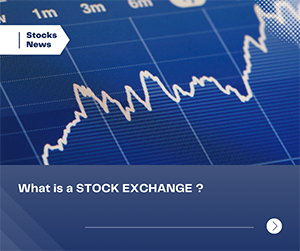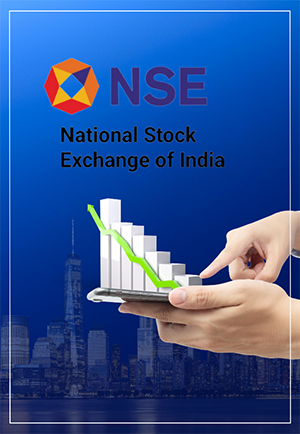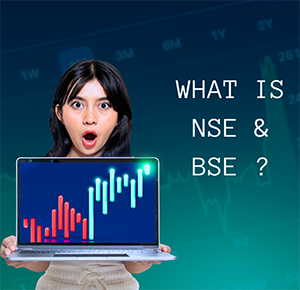Hey there! So, you’ve heard about the NSE and BSE, right? No, I’m not talking about some secret code or a new gaming console. I’m talking about two of India’s major stock exchanges – the National Stock Exchange (NSE) and the Bombay Stock Exchange (BSE). If you’re wondering what sets these two apart or just curious to know the basic differences between them, you’ve come to the right place. Let’s break it down in a way that even your non-financial-savvy friend can understand. So, grab a cup of coffee, kick back, and let’s dive into the world of NSE and BSE!
Table of Contents
What is NSE & BSE?
India boasts a thriving financial market, and at the heart of it are two prominent stock exchanges – the National Stock Exchange (NSE) and the Bombay Stock Exchange (BSE). These exchanges play a pivotal role in shaping the Indian economy by providing a platform for trading stocks, bonds, and other financial instruments. In this blog, we will delve into what NSE and BSE are, their histories, and the key differences that set them apart.
What is a Stock Exchange?

A stock exchange in simple words is a marketplace, where financial securities issued by companies are bought and sold. They are part of the broader capital market ecosystem. Securities issued by companies, such as shares and bonds, are traded on the stock exchanges, after they have been issued in the primary market.
In India there are around 23 Stock Exchanges. Two of them are National Stock exchanges (NSE & BSE) and the other 21 are regional stock exchanges (RSE’s).
What is NATIONAL STOCK EXCHANGE (NSE)?

Established in 1992, the NSE is relatively newer compared to the BSE. It is headquartered in Mumbai, India’s financial capital, and has quickly risen to prominence. NSE’s mission was to bring transparency, efficiency, and technology-driven trading to India’s financial markets. NSE introduced electronic trading, dematerialization of securities, and screen-based trading, revolutionizing how stocks were bought and sold in India.
Understanding the National stock exchange of India Ltd. (NSE)
What are the key Features of NSE?
- Nifty Index: NSE’s flagship index, Nifty, comprises 50 large-cap stocks and is widely used as a benchmark to gauge the performance of the Indian equity market.
- Electronic Trading: NSE pioneered electronic trading in India, allowing for faster and more transparent transactions.
- Wide Range of Products: Besides equities, NSE offers trading in derivatives, bonds, exchange-traded funds (ETFs), and more.
What are the benefits of NATIONAL STOCK EXCHANGE (NSE)?
- Comprehensive marketplace of the Indian capital market.
- Scale and breadth of the operations attract more investors which in turn results in more efficient price discovery.
- Provides high level of trade and post-trade information helping the investor to know depth of the market.
- Largest exchange in India.
- Has unprecedent reach across pan India.
What is BOMBAY STOCK EXCHANGE (BSE)?

The BSE is one of Asia’s oldest stock exchanges, founded in 1875. It is also located in Mumbai and has a rich history deeply intertwined with India’s financial evolution. Traditionally, BSE was known for its open outcry system, where traders physically gathered on the trading floor to execute trades. However, it has since transitioned to electronic trading to keep pace with modern financial markets.
Understanding the Bombay stock exchange (BSE)
What are the key Features of BSE?
- Sensex Index: BSE’s benchmark index, Sensex, comprises 30 of the largest and most actively traded stocks in the Indian market.
- Historical Significance: BSE’s long history makes it a symbol of stability and reliability in the Indian financial landscape.
- Diverse Asset Classes: Similar to NSE, BSE offers trading in equities, derivatives, bonds, mutual funds, and more.
Key Differences Between NSE and BSE:
- When was NSE & BSE established and History?
- NSE was founded in 1992, whereas BSE has been in operation since 1875.
- NSE is known for introducing technological advancements, while BSE has a legacy of traditional trading methods.
- Who has the Ownership and Governance of NSE & BSE?
- NSE: NSE is largely owned by financial institutions, banks, and other big players in the financial world. It’s run by professionals.
- BSE: BSE, in contrast, is more diversified in terms of ownership and has more individual investors involved. It’s also known for having more traditional business families on its board.
- What are the Benchmark Indices of NSE & BSE?
- NSE has Nifty as its flagship index, representing 50 stocks.
- BSE uses the Sensex as its primary benchmark, composed of 30 stocks.
- How does the trading Systems work in NSE & BSE?
- NSE is known for its fully electronic trading platform.
- BSE transitioned from open outcry to electronic trading.
- What is the Market Share of NSE & BSE?
- NSE has gained a significant market share in recent years and is often seen as the preferred exchange for modern traders.
- BSE maintains its historical importance and still attracts a diverse range of investors.
Read Also: Exploring Chennai’s Top 10 Must-Visit Landmarks
So, there you have it – a casual intro to the NSE and BSE, along with some key differences between these two giants of the Indian stock market. Whether you’re planning to invest or just want to impress your friends with some stock market trivia, understanding these distinctions is a good place to start.





